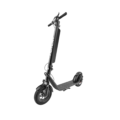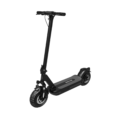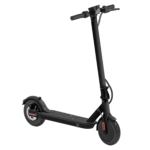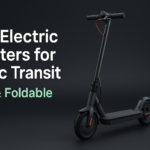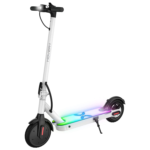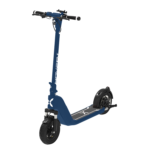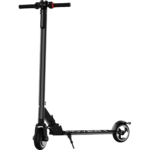- Home
- Scooters
- Electric Scooters
- Hover-1 Blackhawk
Hover-1 Blackhawk
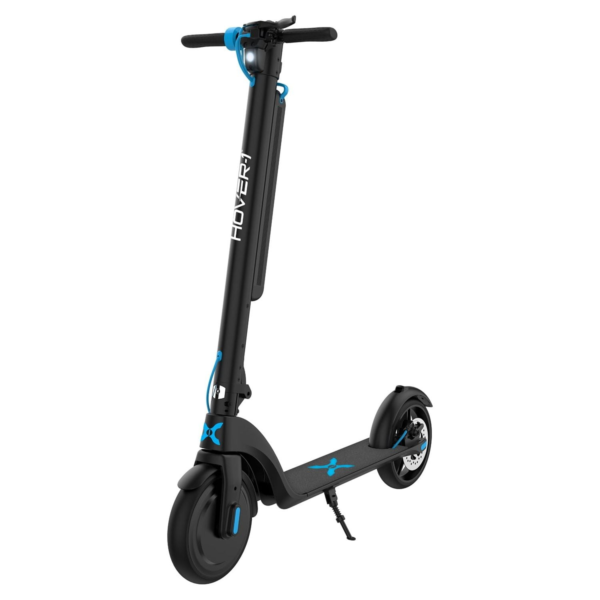


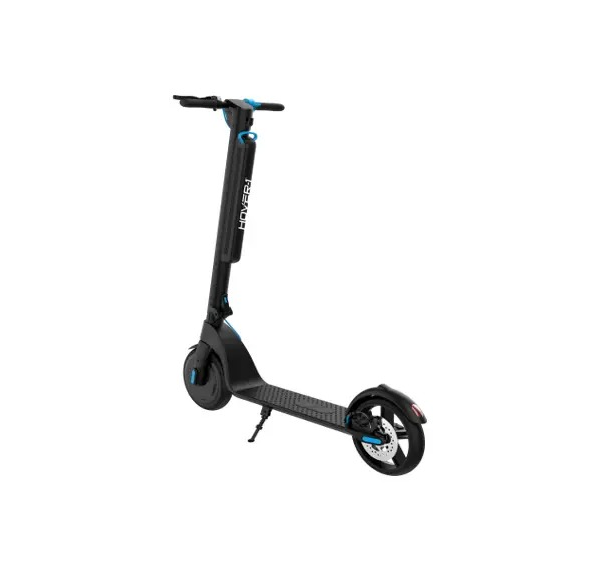
- Battery Range: 28 miles (45 km)
- Top Speed: 18 mph (29 km/h)
- Motor Power: 350 W
- Weight Capacity: 220 lb (99.8 kg)
- Charging Time: Not specified
- Scooter Weight: 33.0 lb (15.0 kg)
PROS
- 18 mph (29 km/h) top speed
- Up to 28 miles (45 km) range
- 10″ pneumatic tires improve comfort
- Rear disc brake + foot brake
- 350W motor with 36V 10Ah battery
CONS
- Heavier at 33 lb (15.0 kg)
- No suspension
- IP rating not specified
- Folded dimensions not specified
Table of contents
- What Is the Hover-1 Blackhawk?
- How the Hover-1 Blackhawk Works
- Key Specifications (clean table)
- Design & Build Quality
- Performance Fundamentals
- Battery, Range & Efficiency
- Ride Quality & Comfort
- Braking & Safety Features
- Portability & Daily Usability
- Maintenance & Care
- Weather & Seasonal Considerations
- Hover-1 Blackhawk vs Alternatives
- Who the Hover-1 Blackhawk Is (and Isn’t) For
- FAQs
- Glossary
- Final Thoughts
If you want a simple, sturdy commuter scooter that keeps daily rides easy, the Hover-1 Blackhawk is a smart place to start. It blends a removable battery, 10-inch pneumatic tires, and a practical folding design into a compact package. If you’re comparing models, see the Hover-1 Stealth review for a different take on geometry and power delivery. Crucially, it favors predictability over flash, which helps new riders feel confident. This overview explains how it works, what the official specifications say, and how to ride and care for it so it lasts.
At a glance: 18 mph (29–34 km/h) top speed, up to 28 miles (45 km) rated range, 36 V / 10 Ah removable battery, 350 W hub motor, rear mechanical disc brake, 10-inch air-filled tires.
What Is the Hover-1 Blackhawk?
The Hover-1 Blackhawk is a folding, adult-size electric kick scooter designed for urban travel and campus hops. It uses a brushless rear hub motor, a removable lithium-ion battery housed in the stem, and a thumb throttle for smooth control. Because it runs on large pneumatic tires and uses a conventional rear disc brake, it delivers a familiar bike-like feel while staying compact enough to bring indoors. Official materials rate top speed at up to 18 mph (34 km/h) and range up to 28 miles (45 km). The scooter itself weighs about 33 lb (15 kg), which is manageable for stairs and transit.
How the Hover-1 Blackhawk Works
Think of the Blackhawk as a simple electric drive added to a sturdy kick scooter.
- Motor & controller: A 350 W brushless hub motor in the rear wheel turns electrical energy into motion. The controller meters power to that motor so acceleration feels steady instead of jumpy.
- Battery: A 36 V, 10 Ah lithium-ion pack slides into the stem and can be removed for charging. Because the pack is in the stem, weight distribution is neutral and the deck stays low.
- Throttle: A right-side thumb throttle commands speed. Press it to go, release to coast. For safety, the scooter requires a short push first (“kick-to-start”) before the motor engages.
- Brakes: You get a hand-actuated rear mechanical disc brake for primary stopping and a backup foot brake on the rear fender for gentle speed control.
- Display & modes: A central LCD shows speed, battery, and mode. Three ride modes—Beginner, Medium, and Sport—let you cap speed while you learn.
- Cruise control: Double-press the throttle to hold your current speed, then press again to disengage. This helps on long, flat stretches.
Key Specifications (clean table)
General
| Item | Spec |
|---|---|
| Model | BMZ-BHWK |
| Net weight | 33 lb (15 kg) |
| Max supported rider weight | 220 lb (100 kg) |
| Min supported rider weight | 44 lb (20 kg) |
| Top speed (rated) | Up to 18 mph (34 km/h) |
| Rated range | Up to 28 miles (45 km) |
| Tire type & size | 10 in pneumatic tires (front & rear) |
| Brake system | Rear hand-actuated mechanical disc + mechanical foot brake |
| Frame/folding | Folding stem with safety latch and ring lock |
| Display | Central LCD (speed, battery, mode indicators) |
| Head/tail lights | LED headlight; rear brake light |
| Cruise control | Double-press the throttle to set/clear |
Performance & Power
| Item | Spec |
|---|---|
| Motor | 350 W brushless rear hub |
| Drive | Controller-regulated with three speed modes (Beginner / Medium / Sport) |
| Kick-to-start threshold | ~1.8 mph (3 km/h) minimum before assist |
| Typical use case | Urban commuting, flat-to-moderate grades |
Battery, Charging & Electrical
| Item | Spec |
|---|---|
| Battery | 36 V, 10 Ah (removable) |
| Energy (derived) | ~360 Wh (36 V × 10 Ah) |
| Charger input | 100–240 V AC, 50/60 Hz |
| Charge time (full) | Up to ~7 hours |
| Operating temperature | 32–104 °F (0–40 °C) |
Build & Dimensions
| Item | Spec |
|---|---|
| Open size | 42.7 × 15.8 × 46.7 in (108.3 × 40 × 118.6 cm) |
| Folded size | 42.7 × 15.8 × 18.2 in (108.3 × 40 × 46 cm) |
| Kickstand | Yes, side-mounted |
| Battery placement | Stem (removable) |
Safety & Control
| Item | Spec |
|---|---|
| Primary brake | Rear mechanical disc (hand lever) |
| Secondary brake | Mechanical foot brake |
| Lights | LED headlight + rear brake light |
| Reflectors | Not supplied; ride with lights and high-visibility gear |
Features & Extras
| Item | Spec |
|---|---|
| Cruise control | Double-press throttle to hold speed |
| Display | Central LCD with speed, battery, and mode icons |
| Speed modes | Beginner / Medium / Sport |
| Folding hardware | Safety latch + ring lock |
| Bell | Included |
| Kickstand | Included |
Warranty & Compliance
| Item | Spec |
|---|---|
| Warranty | 90-day limited parts & labor (manufacturer defects) |
| Water exposure | Do not use when exposed to water; avoid puddles/rain |
| Ingress rating | Not specified |
| Legal use | Follow local rules for riding and equipment |
Note on rated vs real-world results: Top speed and range are lab-style ratings; actual results depend on rider weight, gradients, temperature, and pace.
Design & Build Quality
The Blackhawk’s structure feels familiar to anyone who has used a city rental scooter. The folding stem uses a safety latch and a ring lock, which together reduce play and keep the steering column secure. After long rides, it is wise to check that latch tension remains snug. The manual even shows where to tighten the mechanism if you notice any stem wiggle. This is simple, tool-free upkeep that improves stability at speed.
On the deck, you get a flat standing area with a side kickstand. The battery lives inside the stem and is removable, so you can bring it inside to charge while leaving the scooter in a secure area. That design choice also keeps the deck low, which helps stability when cruising and makes foot placement intuitive.
Up front, the cockpit is clean. The center LCD is easy to read, showing speed, mode, and battery bars. A bell sits on the left near the brake lever, while the thumb throttle sits on the right. Press the power button to wake the system; double-press for headlight control. Because the controls are simple and clearly labeled, the learning curve is short.
Fit-and-finish is consistent for the class. Cable routing is tidy, and the rear disc caliper is mounted where it’s easy to see pad wear. The 10-inch pneumatic tires absorb road chatter better than small solid tires, which is important because the Blackhawk does not use a dedicated suspension fork or rear shock. As a result, it rides best on paved surfaces that are in fair condition.
Performance Fundamentals
Acceleration feel: Power delivery is mild at launch, which is friendly for new riders. Because the scooter is kick-to-start, you’ll push off first, then roll on the throttle to bring the motor in. This sequence prevents accidental take-offs and keeps the deck stable as you balance. In Beginner and Medium modes, throttle response stays gentle; Sport opens the top speed and gives the motor more punch for rolling hills.
Cruising stability: The low deck, tall stem, and 10-inch tires create a planted stance. You can stand with feet staggered and keep your knees soft to settle bumps. As with most scooters in this weight class, stability is best at neighborhood speeds; smooth pavement and steady inputs help most.
Hill-climb behavior (~7–10% grades): On small, sustained grades, the 350 W motor holds a commuter pace if you carry some speed in. On steeper blocks or longer climbs, expect speed to taper. That’s normal for a single-motor scooter using a 36 V system. Shift weight forward slightly to maintain tire grip, and avoid stopping mid-hill. If you must stop, use a strong kick to restart before re-applying throttle.
Battery, Range & Efficiency
The Blackhawk runs a 36 V / 10 Ah pack, which equals about 360 Wh of energy. Translating the rated up to 28 miles (45 km) into real rides depends on several factors: rider weight, average speed, headwinds, temperature, and how many hills you climb. Heavier riders going fast against a breeze will drain the pack faster, while lighter riders cruising steadily at a moderate pace will get closer to the rating. As a rule of thumb, cold weather reduces available capacity, and frequent full-throttle bursts are expensive in watt-hours per mile.
Charging habits: A full charge from low can take up to ~7 hours. Because the battery is removable, you can charge indoors without carrying the whole scooter. For longevity, avoid storing the pack at 0% or 100% for long periods. If the scooter will sit for a while, top it to around the middle of the gauge and check it every month or two. Recharging every couple of months during storage helps preserve health.
Temperature effects: The official operating window is 32–104 °F (0–40 °C). Cold thickens lubricants and reduces battery output; heat stresses components. If ambient temps drift outside that range, ride gently and shorten trips.
Ride Quality & Comfort
Because the scooter uses air-filled 10-inch tires rather than solid rubber, it smooths cracks and seams better than small-wheel commuters. Keep tire pressure appropriate to your weight and the sidewall guidance; under-inflation increases flats and sluggish steering, while over-inflation transmits bumps. There’s no dedicated suspension, so technique matters. Bend your knees, keep arms neutral, and let the tires do their work. On rough patches, reduce speed and stand tall over the deck to let your legs absorb hits.
Handlebar ergonomics are straightforward. The thumb throttle is comfortable for long runs, and the brake lever has a predictable, mechanical feel. Because the deck is low, carving S-lines feels stable. If you notice a hint of stem flex over big bumps, check the latch tension and the ring-lock position; a snug latch keeps steering precise.
Braking & Safety Features
The primary stopper is a rear mechanical disc. It offers firm bite after the lever takes up slack, which makes speed control intuitive. The foot brake is handy for small speed trims or as a backup if the lever is occupied. Use both for controlled hard stops: begin with the hand brake to load the rear tire, then add a touch of foot pressure to balance.
For visibility, the scooter includes an LED headlight and a rear brake light. However, the scooter is not supplied with reflectors and riding with lights and high-visibility clothing is strongly recommended if you’re out at dawn, dusk, or night. If you commute in low light, consider adding aftermarket reflectors or a clip-on rear flasher to your backpack.
Finally, treat water as the enemy. Do not use the scooter when exposed to water. That means avoid rain rides, puddles, and wash-downs. If the scooter gets wet unexpectedly, power it down, dry it thoroughly, and let it rest before charging.
Portability & Daily Usability
At 33 lb (15 kg), the Blackhawk is light enough for short carries and quick station transfers. The folded size—about 42.7 × 15.8 × 18.2 in (108.3 × 40 × 46 cm)—fits under many desks and in car trunks. The folding mechanism uses a safety latch and ring lock; once you learn the sequence, it’s quick. For day-to-day use:
- Fold and lift from the stem below the display to keep the center of mass close.
- Use the kickstand to park without leaning on walls.
- Bring the removable battery indoors to charge while leaving the frame locked in a secure area.
- Enable cruise control on long straights to give your thumb a break, then cancel with a throttle press as traffic changes.
Maintenance & Care
A light routine keeps the Blackhawk dependable:
Before rides (weekly if you commute daily):
- Check tire pressure using a reliable gauge. Look for cuts or embedded debris.
- Squeeze the brake lever; feel for firm engagement without grinding.
- Confirm the folding latch and ring lock are fully seated; tighten if you detect play.
Every 1–2 months:
- Inspect brake pads at the rear caliper; replace when thin.
- Check hardware for torque, especially stem clamp bolts and fender stays.
- Wipe dust from the charge port, make sure the rubber cap seals well, and keep contacts dry.
Battery habits:
- Avoid running the pack to empty or leaving it full for weeks.
- If storing the scooter, charge every couple of months to preserve battery health.
- Only use the supplied charger.
Weather & Seasonal Considerations
Plan rides around both traction and temperature. The recommended operating range is 32–104 °F (0–40 °C). In cold weather, range dips and rubber stiffens, so brake earlier and ride slower. In heat, let the scooter cool after long pulls if the display warns of high temperature. Most importantly, avoid rain and puddles; the scooter isn’t rated for water exposure, and doing so risks component damage. After winter rides on salted paths, wipe down exposed metal to deter corrosion.
Hover-1 Blackhawk vs Alternatives
When you compare commuting scooters, three broad classes emerge:
- Light commuters (single 350–500 W, 8.5–10 in tires): The Blackhawk sits here. It emphasizes simplicity, removable power, and easy maintenance. Its 10-inch pneumatic tires ride smoother than many kick-to-start rivals with smaller wheels.
- Mid-class commuters (larger 36–48 V packs, stronger motors, often dual brakes): These may climb better and stop harder but add weight. If you frequently tackle long, steep hills, you’ll want more motor and voltage.
- Performance/Off-road (dual motors, suspension, wide decks): These cruise faster and soak up rough ground. However, they are heavier, harder to carry, and usually overkill for short city hops.
Because of its removable battery and approachable manners, the Blackhawk excels for apartment dwellers, multi-modal riders, and students who value portability and straightforward upkeep.
Who the Hover-1 Blackhawk Is (and Isn’t) For
Great for:
- Daily commutes across paved city routes at neighborhood speeds.
- Students shuttling between classes with limited storage.
- New riders who want smooth take-offs, clear controls, and predictable brakes.
- Multi-modal travelers who fold, carry, and hop on transit.
Not ideal for:
- Riders needing high-speed highway-adjacent travel.
- Steep-hill neighborhoods where long grades are common.
- Frequent wet-weather commuters who must ride in the rain.
- Anyone seeking heavy-duty suspension or off-road performance.
If your day involves elevators, short flights of stairs, and tight storage, the Hover-1 Blackhawk hits a sweet spot between ride quality and convenience.
FAQs
1) What is the real-world range?
Rated range is up to 28 miles (45 km). Actual results depend on rider weight, temperature, hills, wind, and average speed. Plan conservative routes at first and adjust after a week of rides.
2) How do I use cruise control?
Reach your desired speed, then double-press the throttle to set it. Press the throttle again or use the brake to disengage.
3) Is it safe to ride in the rain?
No. Do not use the scooter when exposed to water. Avoid puddles and wet conditions.
4) What’s the “kick-to-start” requirement?
For safety, the motor will not engage from a standstill. Push to about 1.8 mph (3 km/h), then press the throttle.
5) How long does a full charge take?
From low, budget up to ~7 hours to reach full. The removable battery makes charging indoors easy.
6) What does the LCD show?
Speed, battery level, and ride mode. It also displays warnings, such as high temperature.
7) Where can I find a concise Hover-1 Blackhawk overview?
You’re reading it. This guide covers what it is, how it works, and the core specifications to help you ride and maintain it confidently.
Glossary
- Ah (Amp-hours): Battery capacity measure; higher Ah usually means longer runtime at the same voltage.
- Wh (Watt-hours): Battery energy (V × Ah); a better single number for range potential.
- Brushless motor: Efficient electric motor with permanent magnets; low maintenance.
- Controller: The “brain” that meters battery power to the motor.
- Kick-to-start: Safety feature requiring a push before the motor engages.
- Regen: Electronic braking that recovers energy (not used as a primary stopper here).
- Mechanical disc brake: Cable-pulled caliper squeezing a rotor to slow the wheel.
- BMS (Battery Management System): Circuitry that protects and monitors the battery pack.
- Stem flex: Small movement at the folding joint; minimize by keeping the latch snug.
- IP rating: Ingress Protection score for dust/water; the Blackhawk doesn’t claim one.
- Pneumatic tire: Air-filled tire that cushions bumps and improves traction.
- Mode (Beginner/Medium/Sport): Speed caps and throttle response presets.
- Cruise control: Electronic speed hold to reduce thumb fatigue on straight runs.
- Sidewall pressure: Manufacturer’s inflation range printed on the tire.
- Thermal warning: Over-temperature alert; slow down and cool the system if shown.
Final Thoughts
The Hover-1 Blackhawk aims for a calm, predictable ride rather than raw power. Because it pairs 10-inch pneumatic tires with a removable 36 V battery and a simple rear disc brake, it’s easy to learn, easy to store, and easy to keep running. If your commute is mostly flat and you value convenience, it’s a strong match. Moreover, if you want a scooter that you can fold, carry a short distance, and charge indoors, this one checks the boxes. Finally, treat it well—keep tires pumped, the latch tight, and the battery topped occasionally during storage—and it should return the favor with many smooth miles.
Specifications
General
| Model The Model specifies the exact version or name of the scooter. It helps identify its unique design, features, and specifications within the manufacturer’s product line. Knowing the model makes it easier to compare options, find compatible accessories, or look up support information. | Blackhawk |
| Brand The Brand identifies the manufacturer or company that designs and produces the scooter. A trusted brand is a sign of quality, reliability, and good customer support. Well-known brands often have higher standards for safety, performance, and after-sales service, giving you more confidence in your purchase. | Hover-1 |
| Release Date The Release Date indicates when the scooter model was officially launched on the market. This helps you know how current the design, technology, and features are. A newer release date often means updated components, improved performance, and the latest safety or smart features. | 17 November 2025 |
| Recommended Age Recommended Age indicates the minimum age range that the scooter is designed for, based on safety, size, and ease of use. Following the recommended age helps ensure that riders can handle the scooter’s speed, weight, and controls comfortably and safely. Always check local laws and use protective gear, especially for younger riders. | +16 |
Performance & Power
| Motor Power (Wattage) What it means: The motor power, measured in watts (W), shows how strong the scooter’s electric motor is. Why it matters: Higher wattage usually means better acceleration, more torque, and improved performance on hills or rough terrain. For example, a 250W motor is good for flat city roads and light riders, while a 500W or 1000W motor provides more power for faster speeds or climbing steep inclines. | 350 W brushless motor |
| Top Speed The Top Speed indicates the maximum speed that the scooter can reach under optimal conditions. It’s usually measured on level ground with a fully charged battery and an average rider weight. A higher top speed allows you to travel longer distances faster, but always ensure you ride within legal speed limits and your personal comfort zone for safety. | Up to 18 mph (29 km/h) |
| Battery Capacity Battery Capacity refers to the total amount of energy the scooter’s battery can store, usually measured in ampere-hours (Ah) or watt-hours (Wh). A higher battery capacity means you can ride longer distances on a single charge, reducing the need for frequent recharging. Keep in mind that actual range can vary depending on rider weight, terrain, speed, and weather conditions. | 36 V 10 Ah (360 Wh) |
| Estimated Range per Charge The Estimated Range per Charge indicates the average distance the scooter can travel on a single full battery charge. This range is calculated under optimal conditions, such as flat terrain, moderate speed, and average rider weight. Real-world range may vary depending on riding style, terrain, weather, and load. A longer range means fewer recharges and greater freedom for longer trips. | Up to 28 miles (45 km) |
| Hill Climb Ability Hill Climb Ability describes the maximum incline or slope that the scooter can handle while maintaining stable performance. It’s typically expressed as a percentage or in degrees. A higher hill climb rating means the scooter can tackle steeper hills without losing too much speed or power. Actual climbing performance may vary based on rider weight, battery charge, and terrain conditions. | Not specified |
| Drive System The Drive System refers to how power from the motor is delivered to the wheels. Electric scooters typically use either a hub motor (directly integrated into the wheel) or a chain/belt drive system. A high-quality drive system ensures smooth acceleration, efficient power transfer, and low maintenance. The choice of drive system affects performance, noise level, and overall ride experience. | Not specified |
Charging & Electrical
| Charging Time Charging Time indicates how long it takes to fully recharge the scooter’s battery from empty to 100% using the standard charger provided. Faster charging means less downtime and more time on the road. Actual charging time may vary slightly depending on battery capacity, charger output, and environmental conditions. | Not specified |
| Battery Type Battery Type refers to the specific technology used in the scooter’s battery, which affects performance, lifespan, weight, and charging time. Most modern electric scooters use high-quality lithium-ion (Li-ion) batteries because they offer a good balance of energy density, durability, and low maintenance. A reliable battery type ensures consistent power delivery and longer riding ranges. | Lithium-ion pack with BMS (40-cell) |
| Removable Battery A Removable Battery means the battery pack can be easily detached from the scooter for convenient charging and replacement. This feature allows you to charge the battery separately, swap it with a spare for extended range, or securely store it indoors in extreme weather. Removable batteries add flexibility and make it easier to keep your scooter powered up wherever you are. | Non-removable internal battery (fixed pack) |
| Regenerative Braking Regenerative Braking is an energy-saving feature that converts some of the energy normally lost during braking back into battery power. When you slow down or brake, the motor works in reverse to generate electricity, which helps extend the scooter’s range and improves overall efficiency. This system also reduces wear on traditional brake components, leading to lower maintenance over time. | Not specified |
| Lighting Lighting refers to the built-in front and rear lights that enhance visibility and safety when riding in low-light conditions or at night. Good lighting helps you see the road ahead and ensures that other road users can see you. Many scooters include LED headlights, taillights, and sometimes brake lights or side reflectors for added safety and compliance with local traffic regulations. | LED headlight + rear light/reflectors |
Build & Dimensions
| Scooter Weight Scooter Weight refers to the total weight of the scooter when fully assembled, including the battery. This affects how easy it is to carry, lift, and store the scooter when not in use. A lighter scooter is more portable and convenient for commuting, especially if you need to carry it upstairs or onto public transport. Keep in mind that a sturdy frame and quality components may add to the weight but also contribute to better durability and ride stability. | 33.0 lb (15.0 kg) |
| Maximum Rider Weight Maximum Rider Weight indicates the highest rider weight that the scooter is designed to safely support while maintaining optimal performance and stability. Staying within this limit helps ensure reliable acceleration, braking, and climbing ability, and it protects the frame, suspension, and motor from excessive strain. Exceeding the recommended limit may reduce performance and increase wear on components. | 220 lb (99.8 kg) |
| Deck Size Deck Size refers to the dimensions of the scooter’s standing platform. A wider and longer deck provides more foot space, allowing you to stand comfortably and adjust your stance while riding. A well-sized deck improves balance and stability, especially on longer rides or at higher speeds. Compact decks, on the other hand, help keep the scooter lightweight and portable. | Commuter frame; 10″ pneumatic tires |
| Handlebar Height Handlebar Height refers to the distance from the deck to the handlebars, which affects your riding posture and comfort. An appropriate handlebar height helps you maintain good balance, reduces strain on your back and arms, and makes steering more comfortable. Some scooters have adjustable handlebars to fit riders of different heights, while others have a fixed height for a streamlined design. | Fixed |
| Folding Mechanism The Folding Mechanism describes how easily and securely the scooter can be folded for carrying and storage. A well-designed folding system lets you quickly collapse the scooter into a compact size, making it convenient to transport on public transit, store under a desk, or fit into a car trunk. Look for sturdy latches and safety locks to ensure the scooter stays firmly in place when folded or unfolded. | Folding latch |
| Dimensions Folded Dimensions indicate the size of the scooter when it’s fully folded. This measurement shows how much space the scooter will take up when stored or carried, making it easier to check if it will fit in your car trunk, under a desk, or in a closet. Compact folded dimensions are ideal for commuters who need to bring their scooter on public transport or store it in tight spaces. | Not specified |
| Material Material refers to the primary construction materials used for the scooter’s frame and key components. High-quality materials like aircraft-grade aluminum, reinforced steel, or durable composites provide strength, stability, and a lighter overall weight. A sturdy material ensures the scooter can handle daily wear and tear while maintaining safety and performance. | Not specified |
Safety & Control
| Brake Type(s) Brake Type(s) describe the braking systems the scooter uses to help you slow down or stop safely. Common brake types include mechanical brakes (like drum or disc brakes), electronic brakes, and foot brakes. Many scooters combine multiple braking systems for added safety and shorter stopping distances. The type and quality of brakes affect your control, especially when riding at higher speeds or on slopes. | Handle-activated rear disc + mechanical foot brake |
| Suspension Suspension refers to the system that absorbs shocks and vibrations while riding, providing a smoother and more comfortable ride over uneven or rough surfaces. Scooters may have front suspension, rear suspension, or dual suspension for better shock absorption and stability. Good suspension helps reduce rider fatigue and improves control, especially when riding on bumpy roads or off-road paths. | None |
| Tire Type Tire Type refers to the kind of tires the scooter uses, which directly affects ride comfort, traction, and maintenance. Common types include solid (airless) tires, pneumatic (air-filled) tires, or hybrid options. Pneumatic tires offer better shock absorption and a smoother ride on rough surfaces, while solid tires are puncture-proof and require less upkeep. The right tire type helps ensure safe handling and a comfortable ride in different conditions. | 10″ pneumatic tires |
| Tire Size Tire Size indicates the diameter and width of the scooter’s tires, which affect ride comfort, stability, and how well the scooter handles different terrains. Larger tires generally offer better shock absorption and a smoother ride over bumps and rough surfaces, while smaller tires keep the scooter lighter and more portable. Choosing the right tire size helps ensure a balance between agility and comfort. | 10-inch |
| Kickstand The Kickstand is a built-in stand that allows you to park your scooter upright when it’s not in use. A sturdy kickstand keeps the scooter stable and prevents it from tipping over, protecting it from scratches and damage. It also makes storing and accessing your scooter more convenient, whether you’re at home, work, or on the go. | Side kickstand |
| Water Resistance Rating Water Resistance Rating indicates how well the scooter is protected against water and moisture, usually shown as an IP (Ingress Protection) rating. This rating helps you understand whether the scooter can handle light rain, splashes, or wet roads without damage. While most scooters are not fully waterproof, a good water resistance rating adds peace of mind when riding in changing weather conditions. Always avoid deep puddles or submerging the scooter to protect its electrical components. | Not specified |
Features & Extras
| Display/Console The Display (or Console) shows important real-time information about your ride, helping you monitor your scooter’s status at a glance. Typical displays show speed, battery level, distance traveled, and riding mode. Some models also include additional features like Bluetooth connectivity, app integration, or backlighting for better visibility at night. A clear and easy-to-read display enhances safety and convenience on every trip. | LCD display with speed & battery |
| Ride Modes Ride Modes refer to the different speed and power settings you can choose to match your riding style or road conditions. Common modes include eco for maximum range and energy efficiency, standard for everyday balance, and sport or turbo for higher speed and stronger acceleration. Switching between ride modes allows you to customize performance, conserve battery, and ride safely in various environments. | Multiple speed modes |
| Smart App Connectivity Smart App Connectivity lets you pair your scooter with a dedicated mobile app via Bluetooth. Using the app, you can monitor real-time ride stats like speed, battery level, and range, adjust settings such as ride modes or cruise control, lock the scooter for added security, and sometimes receive firmware updates. This feature adds convenience and allows you to personalize your riding experience right from your smartphone. | No app |
| Anti-Theft System The Anti-Theft System helps protect your scooter from unauthorized use or theft. This feature can include built-in alarms, electronic motor locks, GPS tracking, or remote locking through a mobile app. A good anti-theft system provides peace of mind when parking your scooter in public spaces, adding an extra layer of security to safeguard your investment. | None |
| Cruise Control Cruise Control allows you to maintain a steady speed without continuously holding the throttle. This feature makes longer rides more comfortable by reducing hand fatigue and providing a smoother, more relaxed riding experience — especially on flat, open roads or bike lanes. For safety, cruise control can usually be easily activated or deactivated while riding. | Not specified |
| Accessories Included Accessories Included lists the additional items that come with the scooter to enhance your riding experience and convenience. Common accessories may include a charger, kickstand, bell, lights, phone holder, or carrying strap. These extras add value by making your scooter safer, easier to use, and ready to ride straight out of the box. | Scooter, charger, manual, tools |
Warranty & Compliance
| Warranty Period The Warranty Period indicates how long the manufacturer guarantees the scooter against defects in materials and workmanship under normal use. A good warranty provides peace of mind, showing the brand’s confidence in its product quality. Always check what parts are covered, such as the frame, battery, and motor, and follow the maintenance guidelines to keep your warranty valid. | 90 days limited (manufacturer defects) |
| Certifications Certifications confirm that the scooter meets specific safety, quality, and environmental standards set by recognized organizations or regulatory bodies. Common certifications may include CE, RoHS, UL, or other local compliance marks, depending on your region. These certifications ensure that the scooter is manufactured to high standards and is safe and legal to use in your country. | UL 2272 (as listed); region-dependent |



